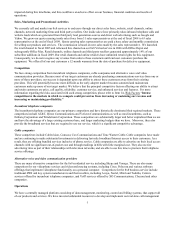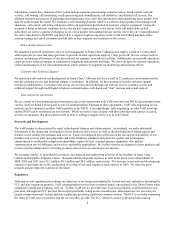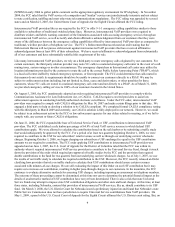8x8 2009 Annual Report Download - page 19
Download and view the complete annual report
Please find page 19 of the 2009 8x8 annual report below. You can navigate through the pages in the report by either clicking on the pages listed below, or by using the keyword search tool below to find specific information within the annual report.17
affected. In particular, if one of our contract manufacturers becomes subject to bankruptcy proceedings, we may not be able to
obtain any of our products held by the contract manufacturer.
We also rely on third party component suppliers to provide semiconductor circuit packages for our products. In some
instances, these components are provided by a single supplier. Our reliance on these suppliers involves a number of risks,
including reduced control over delivery schedules, quality assurance and costs. We currently do not have long-term supply
contracts with any of these component vendors. As a result, most of these third party vendors are not obligated to provide
products or perform services to us for any specific period, in any specific quantities or at any specific price, except as may be
provided in a particular purchase order. The inability of these third party vendors to deliver components of acceptable quality
and in a timely manner, particularly the sole source vendors, could adversely affect our operating results or cause them to
fluctuate more than anticipated. Additionally, some of our products may require specialized or high-performance component
parts that may not be available in quantities or in time frames that meet our requirements.
We may have difficulty identifying the source of the problem when there is a problem in a network.
Our 8x8 service must successfully integrate with products from other vendors, such as gateways to traditional telephone
systems. As a result, when problems occur in a network, it may be difficult to identify the source of the problem. The
occurrence of hardware and software errors, whether caused by our 8x8 service or another vendor's products, may result in the
delay or loss of market acceptance of our products and any necessary revisions may force us to incur significant expenses. The
occurrence of some of these types of problems may seriously harm our business, financial condition or operating results.
Our infringement of a third party’s proprietary technology would disrupt our business.
There has been substantial litigation in the communications, VoIP services, semiconductor, electronics, and related industries
regarding intellectual property rights and, from time to time, third parties may claim infringement by us of their intellectual
property rights. Our broad range of technology, including IP telephony systems, digital and analog circuits, software, and
semiconductors, increases the likelihood that third parties may claim infringement by us of their intellectual property rights.
For example, on May 2, 2008, we received a letter from AT&T Intellectual Property, L.L.C. (“AT&T IP”) expressing the belief
that we must license a specified patent for use in our 8x8 broadband telephone service, as well as suggesting that we obtain a
license to its portfolio of MPEG-4 patents for use with our video telephone products and services. At the same time, we began
an evaluation of whether AT&T IP’ s affiliated entities may need to license any of our patents or other intellectual property.
We have continued to engage in discussions with AT&T IP to explore a mutually agreeable resolution of the parties’ respective
assertions regarding these intellectual property issues. We are unable at this time to state whether we will enter into any license
or cross-license agreements with AT&T IP or whether we ultimately anticipate any material effects on our operating results or
financial condition as a consequence of these matters. If we were found to be infringing on the intellectual property rights of
any third party, we could be subject to liabilities for such infringement, which could be material. We could also be required to
refrain from using, manufacturing or selling certain products or using certain processes, either of which could have a material
adverse effect on our business and operating results. From time to time, we have received, and may continue to receive in the
future, notices of claims of infringement, misappropriation or misuse of other parties' proprietary rights. There can be no
assurance that we will prevail in these discussions and actions or that other actions alleging infringement by us of third party
patents will not be asserted or prosecuted against us.
Certain technology necessary for us to provide our services may, in fact, be patented by other parties either now or in the
future. If such technology were held under patent by another person, we would have to negotiate a license for the use of that
certain technology. We may not be able to negotiate such a license at a price that is acceptable. The existence of such a patent,
or our inability to negotiate a license for any such technology on acceptable terms, could force us to cease using such
technology and offering products and services incorporating such technology. For example, on April 22, 2009, we were named
as a defendant, along with Comcast, Microsoft, Avaya, Embarq, and Qwest, in a complaint filed by Web Telephony, LLC in
the Eastern District of Texas. On April 29, 2009, we entered into a settlement agreement with Web Telephony, which filed a
motion to dismiss the lawsuit on May 8, 2009.
We license technology from third parties that we do not control and cannot be assured of retaining.
We rely upon certain technology, including hardware and software, licensed from third parties. There can be no assurance that
the technology licensed by us will continue to provide competitive features and functionality or that licenses for technology
currently utilized by us or other technology which we may seek to license in the future, will be available to us on commercially
reasonable terms or at all. The loss of, or inability to maintain, existing licenses could result in shipment delays or reductions
until equivalent technology or suitable alternative products could be developed, identified, licensed and integrated, and could
























